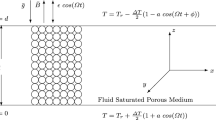Abstract
MHD convection in a horizontal porous-layer filled by a plasma, imbedded in a transverse magnetic field and heated from below, is investigated. The critical Rayleigh number is found and, in simple algebraic closed forms, conditions necessary and sufficient for the onset of steady and oscillatory convection are obtained. It is shown that the stabilizing effect of the magnetic field grows with \(Q^2\), Q being the Chandrasekhar number. The linearization principle (Rionero, Rend Lincei Mat Appl 25:368, 2014): “Decay of linear energy for any initial data implies decay of nonlinear energy at any instant” continues to hold also in the case at stake and allows to recover for the global nonlinear stability the conditions of linear stability.
Similar content being viewed by others
References
Chandrasekhar, S.: Hydrodynamic and Hydromagnetic Stability. Dover (1981)
Merkin, D.R.: Introduction to the Theory of Stability. Texts in Applied Mathematics, vol. 24. Springer, New York, xx+319 pp. (1997)
Nield, D.A., Bejan, A.: Convection in Porous Media, IV edn. Springer, Berlin (2012)
Straughan, B.: The Energy Method, Stability, and Nonlinear Convection, 2nd edn, Appl. Math. Sci., vol. 91. Springer, Berlin (2004)
Straughan, B.: Stability and Wave Motion in Porous Media. Springer, Berlin (2008)
Straughan, B.: Convection with Local Thermal Non-Equilibrium and Microfluidic Effects, Advances in Mechanics and Mathematics. Springer, Berlin (2015)
Mulone, G., Rionero, S.: Non-linear stability analysis of the magnetic Bènard problem through the Lyapunov direct method. Arch. Rational Mech. Anal. 103, 347 (1988)
Mulone, G., Rionero, S.: Necessary and sufficient conditions for nonlinear stability in the Magnetic Bénard problem. Arch. Rational Mech. Anal. 166, 197 (2003)
Rionero, S.: Absence of subcritical instabilities and global nonlinear stability for porous ternary diffusive-convective fluid mixtures. Phys. Fluids 24, 104101 (2012)
Rionero, S.: Multicomponent diffusive-convective fluid motions in porous layers: ultimately boundedness, absence of subcritical instabilities and global nonlinear stability for any number of salts. Phys. Fluids 25, 054104 (2013)
Rionero, S.: Soret effects on the onset of convection in rotating porous layers via the “auxiliary system method”. Ric. Mat. 62(2), 183 (2013)
Rionero, S.: Onset of convection in rotating porous layers via a new approach. AIMS 19(7), 2279 (2014)
Rionero, S.: Heat and mass transfer by convection in multicomponent Navier–Stokes mixture: absence of subcritical instabilities and global nonlinear stability via the Auxiliary System Method. Rend. Lincei Mat. Appl. 25, 368 (2014)
Rudraiah, N.: Linear and non-linear magnetoconvection in a porous media. Proc. Indian Acad. Sci. (Math. Sci.) 93, 117 (1984)
Chambka, Ali J.: Hydromagnetic flow and heat transfer of a heat generating fluid over a surface embedded in a porous medium. Int. Comm. Heat Mass Transfer 24, 815 (1997)
Cheng, Ching-Yang: Effect of a magnetic field on heat and mass transfer by natural convection from vertical surfaces in porous media. An integral approach, Int. Comm. Heat Mass Transfer 26, 935 (1999)
Postelnicu, A.: Influence of a magnetic field on heat and mass transfer by natural convection from vertical surfaces in porous media considering Soret and Dufour effects. Heat Mass Transfer 47, 1467 (2004)
Mansour, M.A., El-Anssaryb, N.F., Alyb, A.M.: Effects of chemical reaction and thermal stratification on MHD free convective heat and mass transfer over a vertical stretching surface embedded in a porous media considering Soret and Dufour numbers. Chem. Eng. J. 145, 340 (2008)
Grosan, T., Revnic, C., Pop, I., Ingham, D.B.: Magnetic field and internal heat generation effects on the free convection in a rectangular cavity filled with a porous medium. Int. J. Heat Mass Transfer 52, 1525 (2009)
Hayat, T., Abbas, Z., Pop, I., Asghar, S.: Effects of radiation and magnetic field on the mixed convection stagnation-point flow over a vertical stretching sheet in a porous medium. Int. J. Heat Mass Transfer 53, 466 (2010)
Alloui, Z., Vasseur, P., Costa, V.A.F., Sousa, A.C.M.: Effect of a non-constant magnetic field on natural convection in a horizontal porous layer heated from the bottom. J. Eng. Math. 81, 141 (2013)
Harfash, A.J.: Structural stability for convection models in a reacting porous medium with magnetic field effect. Ricerche Mat. 63, 1 (2014)
Harfash, A.J.: Convection in a porous medium with variable gravity field and magnetic field effects. Transp. Porous Media 103, 361 (2014)
Acknowledgments
This paper has been performed under the auspices of GNFM of INdAM.
Author information
Authors and Affiliations
Corresponding author
Additional information
Communicated by Salvatore Rionero.
Appendix: Proof of Theorem 7
Appendix: Proof of Theorem 7
Setting
one obtains that the following initial boundary value problem holds
Setting
by virtue of (100)–(101) and (117)–(120) one obtains
Since
and (120) under zero initial boundary conditions admits only the null solution, it follows that
and the theorem is proved.
Rights and permissions
About this article
Cite this article
Capone, F., Rionero, S. Porous MHD convection: stabilizing effect of magnetic field and bifurcation analysis. Ricerche mat. 65, 163–186 (2016). https://doi.org/10.1007/s11587-016-0258-z
Received:
Revised:
Published:
Issue Date:
DOI: https://doi.org/10.1007/s11587-016-0258-z




